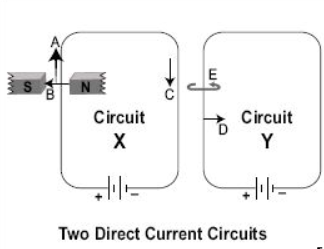Answer
37.2k+ views
Hint: We know that generally, electrons flow from the negative end or terminal to a positive end or terminal. The definition of conventional current can be said as charge per unit time transported in a certain direction. The flow of conventional current is from the positive terminal to the negative terminal. The behaviour is like positive charge carriers will cause the current to flow. It can be assumed as a flow of protons in the opposite direction instead of flow of electrons.
Complete step by step answer:
Arrow A shows the direction of magnetic force experienced by a current-carrying wire in a perpendicular magnetic field and Fleming's left-hand rule gives it.
Arrow B shows the direction of the magnetic field, from the north pole to south pole.
Arrow C shows the direction of conventional current from the positive terminal to the negative terminal of the battery.
Arrow D shows the direction of repulsion force exerted by wire in circuit X to the wire of Y because the direction of current in both parallel wires is opposite.
Therefore, the correct option is (C).
Additional Information: Faraday’s law of EMI “electromagnetic induction”, is also called the law of electromagnetism. This law explains the operational principle of electric generators, electric inductors, electrical transformers, and electric motors. It helps in understanding important points that leads to the electromagnetic induction or production of electricity. Faraday’s law is conducted to see the way magnetic fields change due to the flow of current in wires.
Note: We all know that current is the flow of charges. The main difference between the conventional current and electric current is the direction of flow of charges changes. In the conventional current, it is from positive to negative terminal, whereas it is negative to the positive terminal in electric current.
Complete step by step answer:
Arrow A shows the direction of magnetic force experienced by a current-carrying wire in a perpendicular magnetic field and Fleming's left-hand rule gives it.
Arrow B shows the direction of the magnetic field, from the north pole to south pole.
Arrow C shows the direction of conventional current from the positive terminal to the negative terminal of the battery.
Arrow D shows the direction of repulsion force exerted by wire in circuit X to the wire of Y because the direction of current in both parallel wires is opposite.
Therefore, the correct option is (C).
Additional Information: Faraday’s law of EMI “electromagnetic induction”, is also called the law of electromagnetism. This law explains the operational principle of electric generators, electric inductors, electrical transformers, and electric motors. It helps in understanding important points that leads to the electromagnetic induction or production of electricity. Faraday’s law is conducted to see the way magnetic fields change due to the flow of current in wires.
Note: We all know that current is the flow of charges. The main difference between the conventional current and electric current is the direction of flow of charges changes. In the conventional current, it is from positive to negative terminal, whereas it is negative to the positive terminal in electric current.
Recently Updated Pages
To get a maximum current in an external resistance class 1 physics JEE_Main

f a body travels with constant acceleration which of class 1 physics JEE_Main

A hollow sphere of mass M and radius R is rotating class 1 physics JEE_Main

If the beams of electrons and protons move parallel class 1 physics JEE_Main

Two radioactive nuclei P and Q in a given sample decay class 1 physics JEE_Main

If a wire of resistance R is stretched to double of class 12 physics JEE_Main

Other Pages
A convex lens is dipped in a liquid whose refractive class 12 physics JEE_Main

Differentiate between homogeneous and heterogeneous class 12 chemistry JEE_Main

Explain the construction and working of a GeigerMuller class 12 physics JEE_Main

In the given circuit the current through the 5mH inductor class 12 physics JEE_Main

Formula for number of images formed by two plane mirrors class 12 physics JEE_Main

Identify which of the above shown graphs represent class 12 physics JEE_Main




